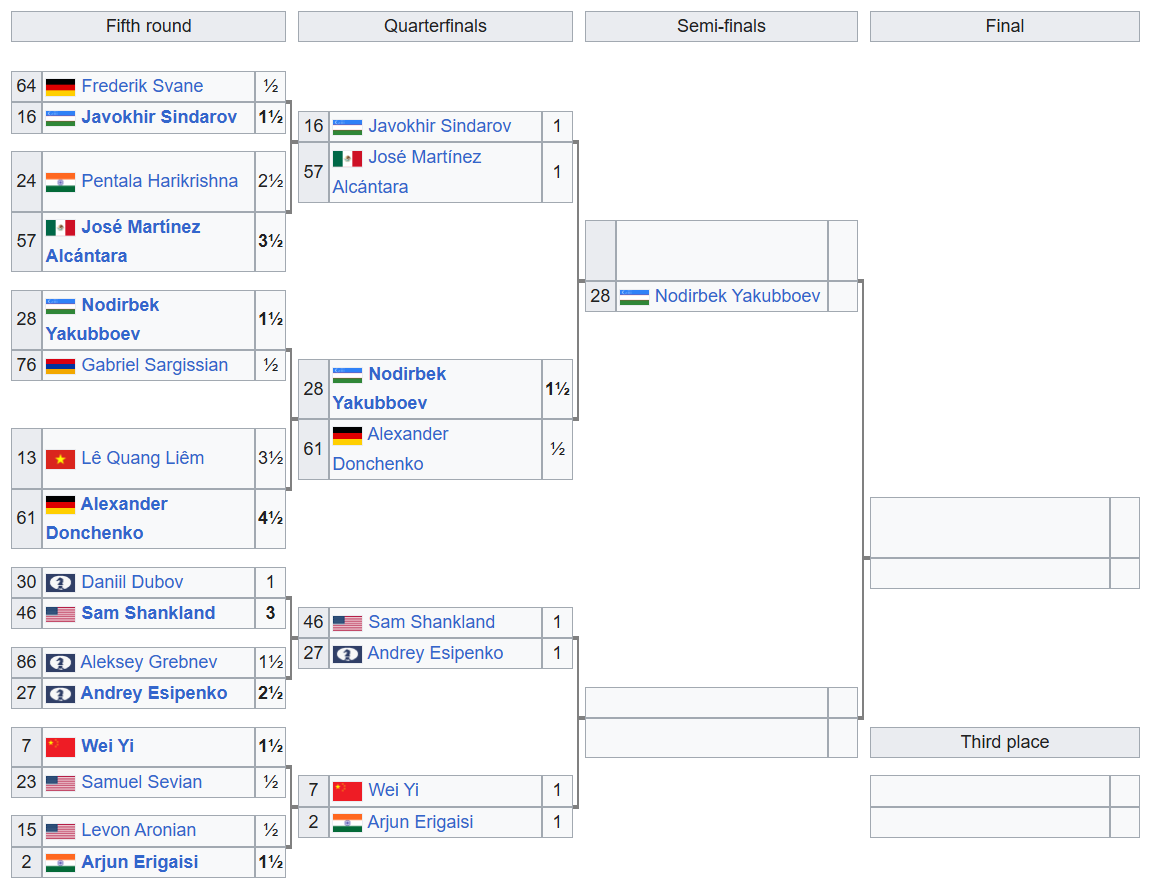Three matches go to tiebreaks
Nodirbek Yakubboev became the first player to reach the semifinals of the FIDE World Cup after securing the draw he needed against Alexander Donchenko on Tuesday in Goa. The Uzbek grandmaster had won the first game of the match on Monday, capitalising on an early opening error by his German opponent. By holding with black in the rematch, Yakubboev moved one step closer to qualification for the 2026 Candidates Tournament.
The 23-year-old from Tashkent now has two opportunities to claim a Candidates spot. Even if he loses his semifinal match – against either Javokhir Sindarov or Jose Martinez – he will have a second chance in the match for third place, as three seats in the Candidates are awarded through the World Cup.
To secure Tuesday’s draw, Yakubboev entered a line of the Nimzo-Indian in which he accepted structural weaknesses in return for a solid, resilient position. Donchenko pressed for winning chances deep into the rook endgame, but despite having an extra pawn, he could not create serious winning prospects. After 57 moves, the German grandmaster agreed to a draw, confirming Yakubboev’s place in the last four.
In today’s fast-paced chess world, especially online, where blitz and rapid games dominate, the traditional approach of grinding through lines of opening theory can feel overwhelming, and even unnecessary. The real challenge? Striking the right balance in your opening preparation. How deep should you go? Where do you stop? This course is built on the timeless wisdom of my legendary coach, Chebanenko, who designed opening repertoires for his “lazy” students – not lazy in attitude, but smart in approach. His philosophy? Don’t memorise. Understand.

Alexander Donchenko had a great run in Goa – he knocked out, among others, Anish Giri, Matthias Bluebaum and Le Quang Liem | Photo: Michal Walusza
The day’s three remaining quarterfinal games were all drawn, meaning that the corresponding matches will be decided in Wednesday’s rapid and blitz tiebreakers. Arjun Erigaisi came closest to scoring a full point, but missed a tactical idea in a Semi-Slav structure, allowing Wei Yi to survive and maintain his own bid for a Candidates berth.
The other two encounters, Jose Martinez v. Javokhir Sindarov and Andrey Esipenko v. Sam Shankland, were calmer affairs. Martinez and Sindarov agreed to peace after just over half an hour, having followed a forcing line that leads to a balanced position – one that nevertheless contains several good-looking king manoeuvres that are only moves (see below in the article the game annotated bý GM Kartsen Müller). Esipenko and Shankland also drew after a level struggle, setting up three high-stakes tiebreak matches on Wednesday.

Donchenko ½-½ Yakubboev
Analysis by Johannes Fischer
In this insightful video course, Grandmaster David Navara shares practical advice on when to calculate deeply in a position — and just as importantly, when not to.
Free sample video: Introduction
Free sample video: Invisible moves

A total of 206 players started the competition and, after Wednesday’s tiebreakers, only four will remain in contention | Photo: Michal Walusza
Erigaisi ½-½ Wei
Analysis by Johannes Fischer
If one skill decides more games, it’s calculation. Openings fade, plans change – but seeing clearly, comparing lines, and choosing with confidence wins points. In this course GM Ganguly turns calculation into a trainable skill with a structured path for any level. You won’t just solve tactics; you’ll learn how to think: where to start, which branches to explore, when to stop, and how to keep a crystal-clear mental board under pressure.
Free video sample: Introduction
Free video sample: Forcing moves

Arjun Erigaisi | Photo: Michal Walusza
Martinez ½-½ Sindarov
Analysis by Karsten Müller
Picture this: you’ve outplayed your opponent move by move, you’re clearly better – and then the endgame slips into a draw, simply because you lacked the crucial theoretical knowledge. That is exactly where this course comes in. Without solid endgame skills, there’s no way forward. Rook endgames are most essential: they occur more often than any other type of endgame, and often make the difference between victory and half a point. If you master them, you’ll confidently convert your advantages into wins!
Free video sample: Introduction
Free video sample: Bodycheck

Jose Martinez and Javokhir Sindarov got plenty of time to prepare for the tiebreaks after signing a very quick draw | Photo: Michal Walusza
All games – Quarterfinals
Replay games from all rounds at Live.ChessBase.com
EXPAND YOUR CHESS HORIZONS
Data, plans, practice – the new Opening Report In ChessBase there are always attempts to show the typical plans of an opening variation. In the age of engines, chess is much more concrete than previously thought. But amateurs in particular love openings with clear plans, see the London System. In ChessBase ’26, three functions deal with the display of plans. The new opening report examines which piece moves or pawn advances are significant for each important variation. In the reference search you can now see on the board where the pieces usually go. If you start the new Monte Carlo analysis, the board also shows the most common figure paths.
